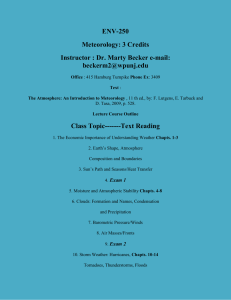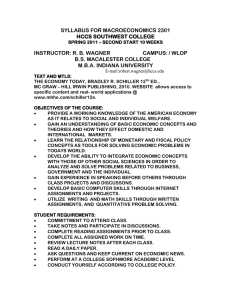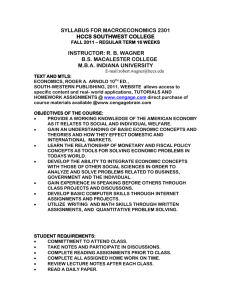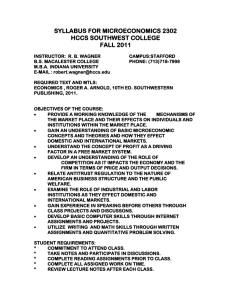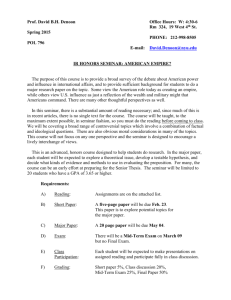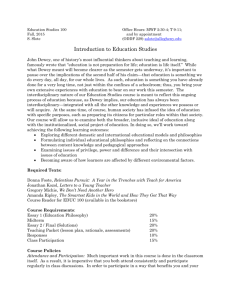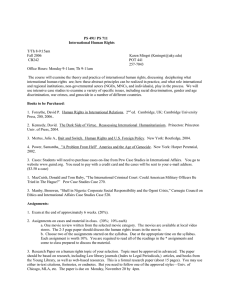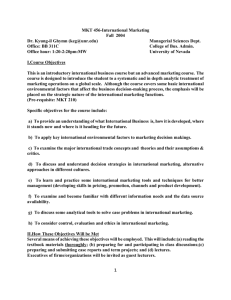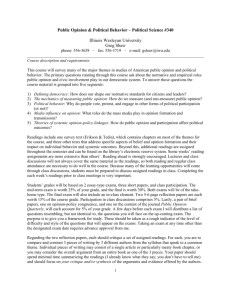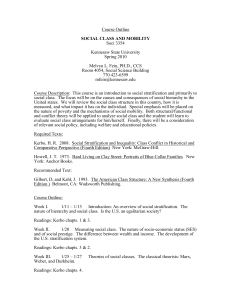Earth Resources and Environmental Impact of their Exploitation: 270
advertisement
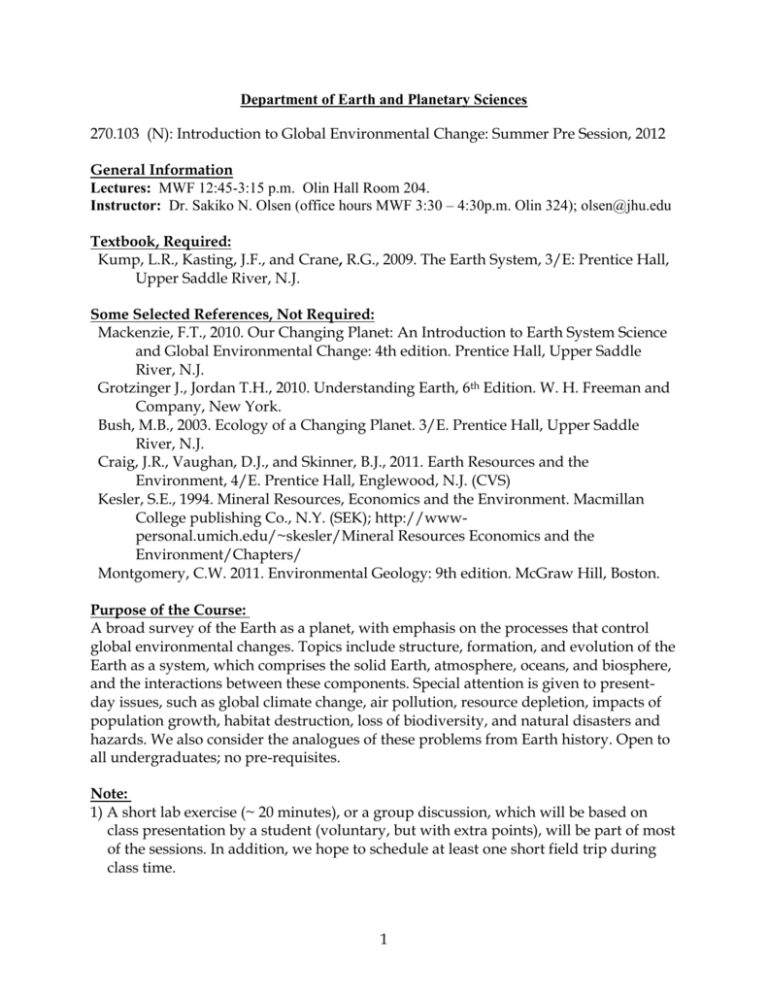
Department of Earth and Planetary Sciences 270.103 (N): Introduction to Global Environmental Change: Summer Pre Session, 2012 General Information Lectures: MWF 12:45-3:15 p.m. Olin Hall Room 204. Instructor: Dr. Sakiko N. Olsen (office hours MWF 3:30 – 4:30p.m. Olin 324); olsen@jhu.edu Textbook, Required: Kump, L.R., Kasting, J.F., and Crane, R.G., 2009. The Earth System, 3/E: Prentice Hall, Upper Saddle River, N.J. Some Selected References, Not Required: Mackenzie, F.T., 2010. Our Changing Planet: An Introduction to Earth System Science and Global Environmental Change: 4th edition. Prentice Hall, Upper Saddle River, N.J. Grotzinger J., Jordan T.H., 2010. Understanding Earth, 6th Edition. W. H. Freeman and Company, New York. Bush, M.B., 2003. Ecology of a Changing Planet. 3/E. Prentice Hall, Upper Saddle River, N.J. Craig, J.R., Vaughan, D.J., and Skinner, B.J., 2011. Earth Resources and the Environment, 4/E. Prentice Hall, Englewood, N.J. (CVS) Kesler, S.E., 1994. Mineral Resources, Economics and the Environment. Macmillan College publishing Co., N.Y. (SEK); http://wwwpersonal.umich.edu/~skesler/Mineral Resources Economics and the Environment/Chapters/ Montgomery, C.W. 2011. Environmental Geology: 9th edition. McGraw Hill, Boston. Purpose of the Course: A broad survey of the Earth as a planet, with emphasis on the processes that control global environmental changes. Topics include structure, formation, and evolution of the Earth as a system, which comprises the solid Earth, atmosphere, oceans, and biosphere, and the interactions between these components. Special attention is given to presentday issues, such as global climate change, air pollution, resource depletion, impacts of population growth, habitat destruction, loss of biodiversity, and natural disasters and hazards. We also consider the analogues of these problems from Earth history. Open to all undergraduates; no pre-requisites. Note: 1) A short lab exercise (~ 20 minutes), or a group discussion, which will be based on class presentation by a student (voluntary, but with extra points), will be part of most of the sessions. In addition, we hope to schedule at least one short field trip during class time. 1 2) There will be two midterm and one final exams, one-hour each. The grade will be based mostly on the exams and partially on class presentation when applicable. 2 Outline of the Course Schedule Week Date 1 2 Topics May 21 Introduction: Scientific methods. Concept of system Earth as a system: composition, structure, and evolution of planet Earth, Earth’s space and time scales, age of the Earth. Solar system; the Sun, other planets, orbital parameters for Earth. Lab exercise: measuring properties of Earth materials Reading: Chapts. 1, 2, 4, 10, 12, 14, 19 May 23 Earth’s evolving interior: Plate tectonics I: building blocks of solid Earth, minerals , and mineral evolution, rocks, and rock cycles, soil, the theory of Plate Tectonics. Lab exercise: crystals/minerals Reading: Chapt. 7 May 25 Earth’s lithosphere: Plate tectonics II: Earth’s internal processes, volcanoes, earthquakes, geologic hazards:, Lab exercise: igneous rocks. Reading: Chapt. 7 May 30 Earth’s lithosphere and surface processes: geologic hazards (continued): Great Tohoku Earthquake of Japan, 2011, a natural and man-made disaster. Lab exercise: more rocks Reading: Chapt. 7 The Fluid Earth: Atmosphere I: Structure of atmosphere, weather/climate and predictions. Reading: Chapts. 3, 4 June 1 The Fluid Earth: Atmosphere II: Air-sea interaction: El NinoSouthern Oscillation and other decadal oscillations Reading: Chapts. 3, 4 Midterm I (1 hour) 3 June 4 The Fluid Earth: Hydrosphere: Water cycle, water reservoirs. Ocean. Cryosphere. Lab exercise: soil and groundwater Reading: Chapts. 5, 6, 12, 14 June 6 Earth’s ecosphere: classification of the biota. Biotic and abiotic 3 components of an ecosystem. Biodiversity, extinction. Origin and evolution of life. Lab exercise: fossils Reading: Chapts. 9, 10, 11, 12, 13, 18 June 8 4 Biogeochemical cycles of C, O, N, S, P: photosynthesis/respiration, longer-term cycling, human interference Lab exercise: remote sensing Reading: Chapt. 8, 11 June 11Human forcing on the ecosphere: population, development, and resource consumption: the need for livable environment and resources. Resources and consumptions I: Mineral resources. Resources and reserves. Resources and consumptions II: Energy resources: fossil fuels, alternative energy resources. Lab exercise: coal/oil shale Reading: Chapt. 9, 15, 16, 18 June 13 Resources and consumptions II (continued): Energy resources: fossil fuels, alternative energy resources. Reading: Chapt. 9, 15 Midterm II (1 hour) June 15 The changing Earth surface I: Terrestrial vegetation. Forests, agrosystems, fertilizers and other human interference. Land use. The changing Earth surface II: Land and water. Soil ecosystem: soil as resource. Land-water ecosystem Reading: Chapts. 2, 10, 11. The changing atmosphere: Acid deposition and photochemical smog: acid rain, air pollution, stratospheric ozone depletion Lab exercise: JHU power plant visit (to be arranged) Reading: Chapts. 1, 11, 17 5 June 18 Changing ecosphere: Pleistocene/Holocene, and other long-term environmental changes: records of climate, ice cores, ice ages, ice and hot houses, Milankovitch cycles Reading: Chapts. 12, 13, 14 Climate change I: Global warming, greenhouse effect and climatic change. Class presentations/discussions? 4 Reading: Chapt. 1, 3, 13, 15, 16 June 20 Climate change II: Mitigation and preparations for global changes: Human dimensions of global environmental change: what we know, what we must do, environmental goals, sustainability, other habitable worlds? Class presentations/discussions? Reading: Chapts. 12, 16, 19 June 22 Conclusions/ Class presentations/discussions: Final Exam (1 hour) 5
